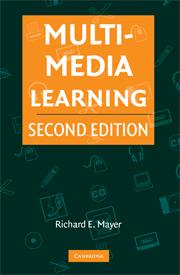Book contents
- Frontmatter
- Contents
- PREFACE
- SECTION I INTRODUCTION TO MULTIMEDIA LEARNING
- SECTION II PRINCIPLES FOR REDUCING EXTRANEOUS PROCESSING IN MULTIMEDIA LEARNING
- SECTION III Principles for Managing Essential Processing in Multimedia Learning
- SECTION IV PRINCIPLES FOR FOSTERING GENERATIVE PROCESSING IN MULTIMEDIA LEARNING
- 12 Multimedia Principle
- 13 Personalization, Voice, and Image Principles
- SECTION V CONCLUSION
- REFERENCES
- AUTHOR INDEX
- SUBJECT INDEX
- References
13 - Personalization, Voice, and Image Principles
- Frontmatter
- Contents
- PREFACE
- SECTION I INTRODUCTION TO MULTIMEDIA LEARNING
- SECTION II PRINCIPLES FOR REDUCING EXTRANEOUS PROCESSING IN MULTIMEDIA LEARNING
- SECTION III Principles for Managing Essential Processing in Multimedia Learning
- SECTION IV PRINCIPLES FOR FOSTERING GENERATIVE PROCESSING IN MULTIMEDIA LEARNING
- 12 Multimedia Principle
- 13 Personalization, Voice, and Image Principles
- SECTION V CONCLUSION
- REFERENCES
- AUTHOR INDEX
- SUBJECT INDEX
- References
Summary
Personalization Principle: People learn better from multimedia presentations when words are in conversational style rather than formal style.
Example: In a narrated animation on how the human lungs work, personalization involves using “you” and “your” in the narration script – for example, saying “your nose” rather than “the nose” and “your throat” rather than “the throat.”
Theoretical Rationale: When learners feel that the author is talking to them, they are more likely to see the author as a conversational partner and therefore will try harder to make sense of what the author is saying.
Empirical Rationale: In eleven out of eleven tests, learners who received the words of a multimedia lesson in conversational style performed better on transfer tests than learners who received the words in formal style, yielding a median effect size of d = 1.11.
Boundary Conditions: The personalization principle may be most effective when it is not overdone and when the learners are beginners.
Preliminary Research on the Voice Principle: People learn better when narration is spoken in a human voice rather than in a machine voice. The voice principle was supported in three out of three experiments, with a median effect size of d = 0.78.
Preliminary Research on the Image Principle: People do not necessarily learn better when the speaker's image is added to the screen. In five experiments, the median effect size favoring adding the speaker's image to the screen was d = .22, which is in the small-to-negligible range.
Information
- Type
- Chapter
- Information
- Multimedia Learning , pp. 242 - 262Publisher: Cambridge University PressPrint publication year: 2009
References
Accessibility standard: Unknown
Why this information is here
This section outlines the accessibility features of this content - including support for screen readers, full keyboard navigation and high-contrast display options. This may not be relevant for you.Accessibility Information
- 1
- Cited by
